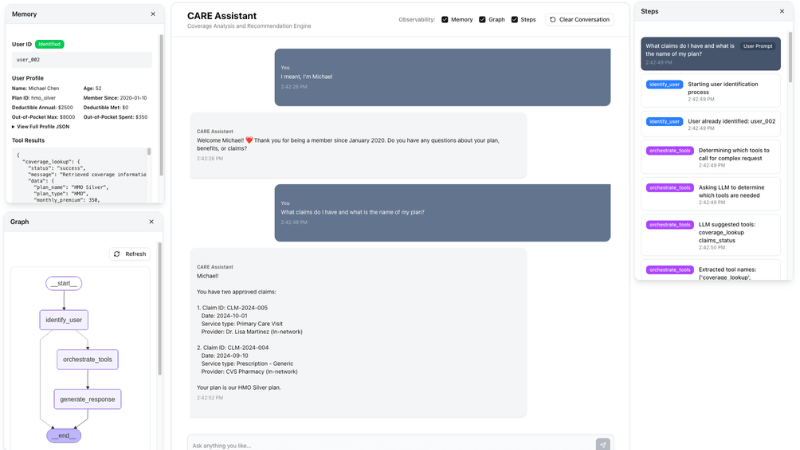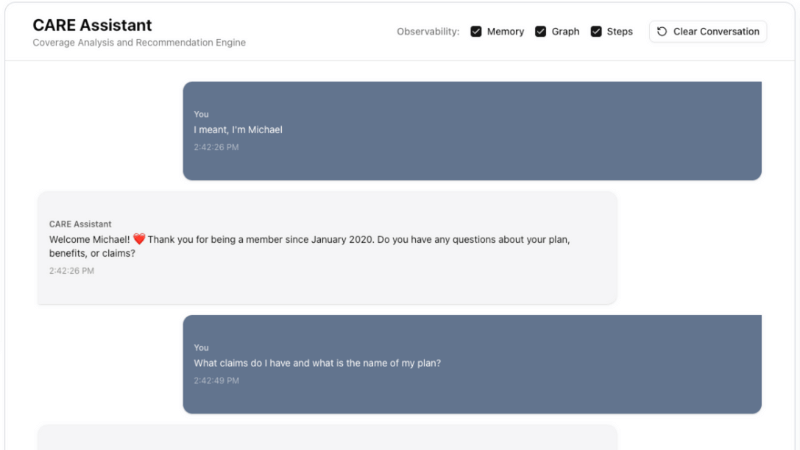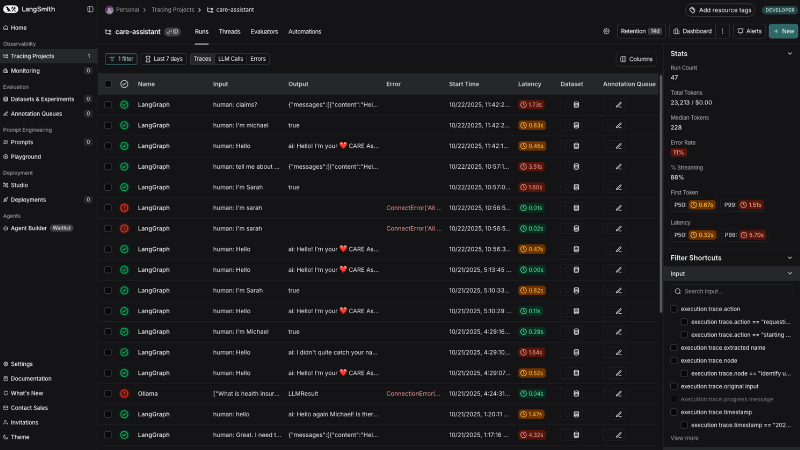CARE Assistant
An AI-powered insurance coverage assistant that helps users understand their healthcare benefits.
🏗️ Architecture
- Backend: Python 3.13 with FastAPI
- LLM Framework: LangGraph 1.0.1 + LangChain 1.0.2
- Local LLM: Ollama (default: llama3.2, configurable)
- Observability: LangSmith (optional cloud tracing)
- Frontend: Next.js 15 + TypeScript + shadcn/ui + Tailwind CSS
- Package Management: uv (Python) + npm (Frontend)
- Data: Mock JSON files (no real APIs or databases)
- Deployment: Static build with single-server architecture
🚀 Getting Started
Prerequisites
Before you begin, ensure you have:
- uv package manager - Install with:
curl -LsSf https://astral.sh/uv/install.sh | sh - Ollama - Download and install from https://ollama.ai/
Step-by-Step Installation
1. Clone the repository and navigate to the project folder
git clone https://github.com/bymarcelolewin/care-assistant.git
cd care-assistant
2. Pull an Ollama model
# Pull the default model used in the code (or any model you prefer)
ollama pull llama3.2
# Or use a larger model for better quality:
# ollama pull llama3.3:70b-instruct-q4_K_S
# Verify the model is available
ollama list
Note: The code is configured to use llama3.2 by default. You can change the model in app/graph/nodes.py to use any Ollama model.
All subsequent commands should be run from this care-assistant directory.
3. Create and activate virtual environment
# Create virtual environment with uv
uv venv --python 3.13
# Activate (macOS/Linux)
source .venv/bin/activate
4. Install Python dependencies
# Install all dependencies from pyproject.toml
uv sync
5. (Optional) Configure LangSmith for tracing
If you want cloud-based observability (optional):
# Copy the environment template
cp .env.example .env
# Edit .env and add your LangSmith API key from https://smith.langchain.com/
# LANGCHAIN_TRACING_V2=true
# LANGCHAIN_API_KEY=your_api_key_here
Note: The app works perfectly without LangSmith.
6. Build the frontend
cd frontend
npm install
npm run build
cd ..
This creates the static frontend files in frontend/out/ that the backend will serve.
7. Verify installation
# Test Ollama integration
python tests/test_ollama.py
If successful, you should see: ✅ Ollama integration test PASSED!
🏃 Running It
From the care-assistant directory, make sure Ollama is running, then start the server:
uv run uvicorn app.main:app --port 8000
When the server starts successfully, you should see:
🚀 Starting CARE Assistant - Coverage Analysis and Recommendation Engine...
📚 Version 0.9.0
📂 Loading mock data...
✓ Loaded 3 user profiles
✓ Loaded 3 insurance plans
✓ Loaded 9 claims records
✅ Application startup complete!
Open your browser to: http://localhost:8000/
That’s it! You should see the CARE Assistant chat interface.
Note: The backend serves the pre-built static frontend from frontend/out/. If you make changes to the frontend, rebuild it with cd frontend && npm run build && cd ..



